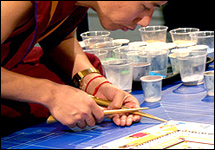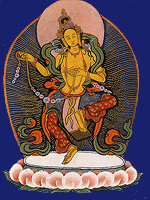
Photo by Kim Yanoshik |
A mandala (Tibetan: dkyil-'khor) is a visual representation of a tantra, or, a body of beliefs and teachings. Mandalas can be constructed in materials like sand, paint, and wood, or they can be actualized meditatively. The Kalachakra Mandala is a visual depiction of the Kalachakra Tantra - one of the most advanced and complex teachings of Buddhism.
|
The sand mandala is typically drawn in sand using a chakpu - a metal funnel with an opening through which sand is tapped out. The sand image is intended to be a two-dimensional representation of Kalachakra's three-dimensional palace, therefore it is drawn in plan view.
|

Photo by Kim Yanoshik
|

Image from Kalachakra |
The word Kalachakra (Sanskrit: कालचक्र) means "Wheel of Time," and it is the name of the primary deity who resides in the Kalachakra mandala. In Buddhist teachings, Kalachakra is time itself.
Kalachakra is described as having black skin, four faces (one black, one white, one yellow, and one red), twelve arms, and twenty four hands. He is represented by a vajra (or, "thunderbolt"), drawn in blue sand in the very center of the mandala.
|
The palace contains
five stories, each divided into
four quadrants by compass direction. Each quadrant is colored so as to represent the elements within the human body;
East corresponds with the color black,
North corresponds with white,
West with yellow, and
South with red (just as the four faces of Kalachakra are colored). The five stories consist of the
Enlightened Body,
Enlightened Speech,
Enlightened Mind,
Enlightened Wisdom, and
Enlightened Great Bliss. They are drawn as exponentially-proportioned mandalas nested within each other.
Beneath the palace are
four elemental rings and
two outer rings (for a total of six). From the inside outward, they consist of rings of earth, water, fire, wind, space, and wisdom.


Image from Kalachakra |
Dwelling within each story of the mandala and some of the outer elemental rings is a total of 722 deities, both male and female, of varying colors, dispositions, and symbolisms. They are usually depicted as dots called bindus resting on the petals or centers of lotuses. The sand mandala is drawn as a temporary home for these deities.
|

|
As the final step in the process, the deities are dispersed through prayer, and the sand mandala is
dismantled. The energy of the mandala is cut along the orthogonal
Brahman lines using a vajra, and the sand is swept into the center and eventually into a special urn. On the edge of a body of water, such as a
river or an
ocean, monks pray for the
purification of the environment and those within it. The sand is then poured into the water, as an offering for the
welfare of all beings. Many of those who are unfamiliar with Buddhist thought are confused or taken aback by the destruction of the intricately detailed mandala. However, the dismantling serves an important purpose in acknowledging the
impermanence of all aspects of life.






